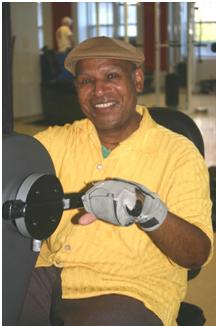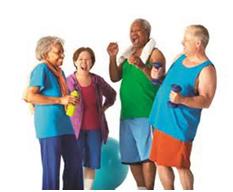By NCHPAD
Cross-promoted from the NCHPAD News: Volume 12, Issue 1
Written by: Carol Kutik, Director of Fitness & Health Promotion at the Lakeshore Foundation
Never! Even if you have had an inactive lifestyle, research suggests that you are never too old to benefit from exercise. The National Institutes of Health (NIH) report that even moderate physical activity can improve the health of older adults who are frail, or who have diseases that accompany age. A substantial number of research studies confirming the many benefits of regular physical activity for older adults helped the U.S. government to report in its 2008 Physical Activity Guidelines for Americans that, compared to less active people, more active people have lower rates of all-cause mortality, coronary heart disease, high blood pressure, stroke, type 2 diabetes, metabolic syndrome, colon cancer, breast cancer, and depression. The Guidelines add that “regular physical activity is essential for healthy aging.” Note the word essential, as opposed to the word suggested.
Despite the known benefits of physical activity, the NIH reports that rates are low among older people. Only about 30 percent of adults between age 45 and 64, 25 percent between age 65 and 74 years, and 11 percent age 85 and older engage in regular physical activity. Physical activity rates for older adults with physical disabilities are even lower. According to a study by the Centers for Disease Control and Prevention regarding adults age 50 and over, approximately 70 percent of those with disabilities do not participate in recommended amounts of physical activity, as compared to 60 percent of those without disabilities.
As older individuals become less active, they begin to lose their ability to perform standard daily living activities and become discouraged and reluctant to exercise, fearful that it will be too strenuous and cause them harm. All too often, decreased levels of both physical function and independence are accepted as natural consequences of aging, leading older adults to believe that exercise is not “for them” and perpetuating the downward spiral. Research from the NIH shows that the opposite is true – that exercise is safe for people of all age groups, and that older adults hurt their health far more by not exercising than exercising.
The following types of exercise are recommended for seniors who want to stay healthy and independent:

- Strength exercises build muscles and increase metabolism (which helps with weight control). Strength exercises can be performed by using machines, free weights, working with resistance bands, using your own body weight (push-ups, pull-ups, sit-ups, etc.), heavy gardening, yoga and other methods.
- Endurance exercises improve the ability of your heart and lungs to work efficiently. Any activity that increases heart rate and breathing will help build endurance. Try walking, pushing, swimming, cycling or raking leaves!
- Stretching exercises keep joints and muscles limber, which can give you more freedom of movement. Special attention is important for joints that are particularly tight.
- Balance exercises can help avoid falling, as well as build strength and postural awareness.
The following steps will help guide you in your new exercise routine:
- First, make a commitment to yourself. Keep in mind that research tells us it takes most people 21 days to develop a new habit. Get out your calendar and plan those first 21 days – the rest will follow!
- Start out slowly, especially if you have been inactive for a long time, and set realistic short-term goals. Seek the advice of a fitness professional who is experienced in working with older adults. If you are computer savvy, use the internet to find exercises that you enjoy. Explore NCHPAD’s multitude of exercise programs. Check out EASY (www.easyforyou.info), a website developed to help older adults identify the physical activity programs most suited to their personal needs, preferences, and health conditions.
- Use your own body awareness as your guide. Pay attention to how you feel before, during, and after exercise, and adjust your pace as needed. Keep in mind that it will take you a while to know when it’s just right, but trust me, when you experience that awesome feeling you will be hooked!
- Reward yourself along the way as you reach small goals to keep the habit.
